In this article, you’ll learn what is CNC machine is with its working principle, basic elements, advantages, applications, and PDF that you can download at the end of the article.
CNC Machine:
In a CNC machine, all the numerical functions are controlled by the computer. The computer stores the programs which are required to operate the machine.
The computer also gives the display of various parameters of the machine-like spindle speed, feed rate, etc. It consists of electronic instrumentation to measure the output.
CNC stands for computer numerical control. It is a machine controlled by a computer. Its external appearance is similar to that of an NC machine. Tape or Computer Keyboard or Tutor Keyboard is used as input media for CNC machines. For NC machines tape is to be fit repeat to produce repeated jobs.
But for CNC machines tape is fit once and the program is stored in the memory and can be run repeatedly to produce repeated jobs. CNC or computer numerical control is an NC system that employs a dedicated microcomputer as a machine control unit.
The presence of a microprocessor, RAM memory, ROM memory, input and output devices have increased the level of automation in NC systems. CNC Machine is designed to perform multiple operations in a faster way which increases the flexibility of the machine.
Read also:
- What is Shaper Machine and Types
- Lathe Machine: Parts, Types, Operations, Accessories,
- Drilling machine – Parts, Types, Operations and with PDF
Basic CNC Concept
A CNC system can be described in terms of three major elements:
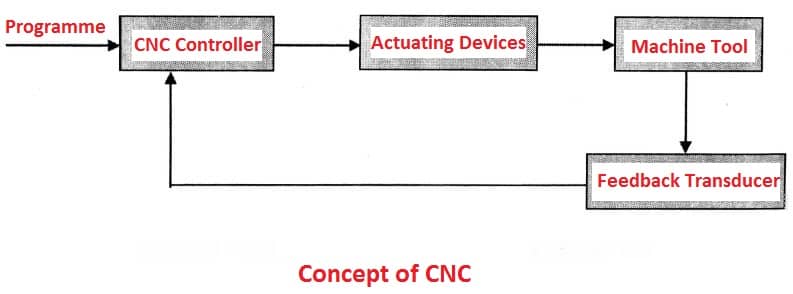
- Hardware,
- Software and
- Information.
1. Hardware:
A Hardware includes microprocessors that affect control system functions and peripheral devices for data communication, machine tool status monitoring, and machine tool interfacing.
2. Software:
The software includes programs that are performed by system microprocessors and there are different types of software associated with CNC.
3. Information:
Information about the dynamic characteristics of the machine and much other information related to the process. When any of these deceptive components fail, the diagnostics subsystem will automatically separate the faulty component from the system and activate the unnecessary component in place of the damaged one so that the newly installed component can perform its task.
Features of CNC Machine
The feature of CNC machines are as follows:
- Part program input may be through the keyboard.
- The part program is entered into the computer and stored in the memory. Then it is used again and again.
- The entered part program can be edited for any errors or design changes.
- A graphical display of the cutter path and shape of the finished work is possible before actually running the program (simulation).
- Tool wear compensation is possible.
- Able to get machine utilization information’s like the number of components produced, time per component, time for setting the job etc.,
- The sub-program facility is also possible for repetitive machining sequences.
Basic Elements of the CNC Machine
The main parts of the CNC machine are:
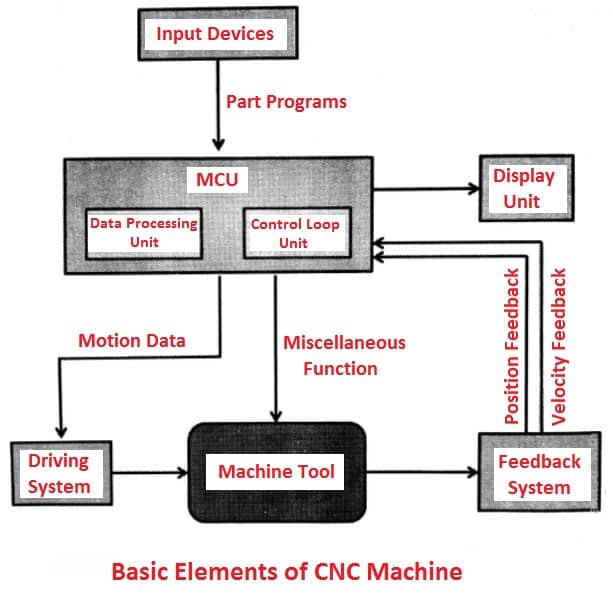
- Input devices
- Machine control unit (MCU)
- Machine tool
- Driving system
- Feedback system
- Display uni
1. Input Devices:
These are devices that are used to input the part program into a CNC machine. There are three generally used input devices and these are punch tape reader, magnetic tape reader and computer via RS-232-C communication.
2. Machine Control Unit (MCU):
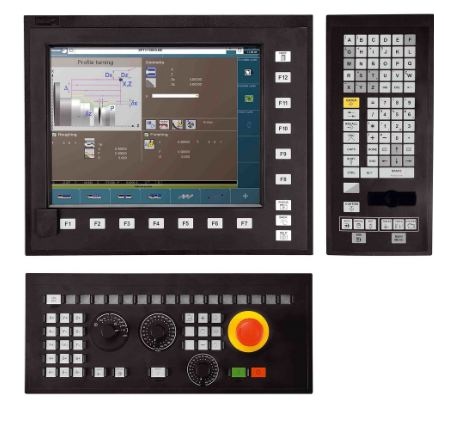
The machine control unit is called the heart of the CNC machine. It performs all the control functions of the CNC machine, there are various tasks performed by MCU that are
- It reads the coded instructions given in it.
- Machine control unit decodes the coded instruction.
- This axis implements interpolation (linear, circular and helical) to generate motion commands.
- Machine control unit feeds the axis motion command to the amplifier circuit to drive the axis mechanism.
- It takes a feedback signal of position and speed for each drive axis.
- It implements the auxiliary control functions such as coolant or spindle on/off and tool change.
3. Machine Tool:
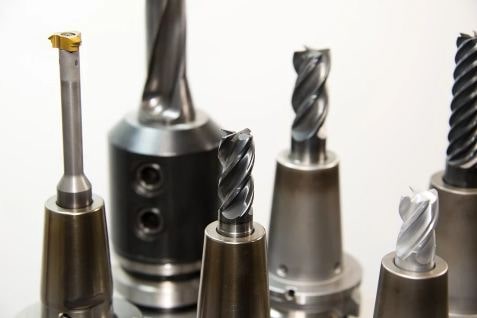
A CNC machine tool always has a sliding table and a spindle to control the position and speed. The table of the machine is controlled in the X and Y-axis direction and the spindle is controlled in the Z-axis direction.
4. Driving System:
The driving system of a CNC machine include of an amplifier circuit, drive motors, and ball lead screws. The MCU supplies the signals (ie, of position and speed) of each axis to the amplifier circuits. The control signals are then augmented (increased) to actuate the drive motors. And the actuated drive motors rotate the ball lead screw to put in position the machine table.
5. Feedback System:
The feedback system has transducers that act as sensors. It is also called a measuring system. It consists of position and speed transducers that continuously monitor the position and speed of the cutting tool located at any given moment.
The MCU receives signals from transducers and it uses the difference in reference signals and feedback signals to generate control signals to correct position and speed errors.
6. Display Unit:
The monitor is employed to display programs, commands and other useful data of the CNC machine.
Read also:
How CNC Machine Works?
The figure shows the CNC machine working:
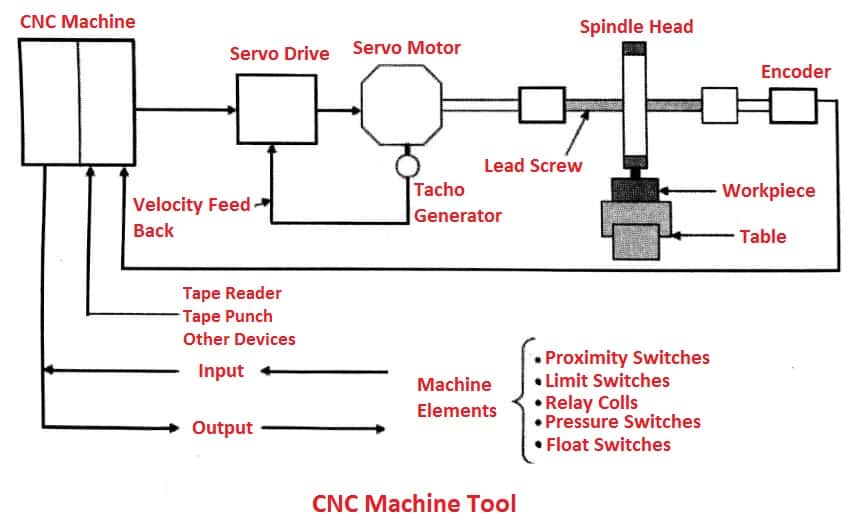
First, the part program is entered into the MCU of the CNC.
The MCU processes all the data and according to the program prepared, it prepares all the motion commands and gives them to the driving system.
The drive system acts as motion commands sent by the MCU. The drive system manages the motion and velocity of the machine tool.
The feedback system records the position and velocity measurements of the machine tool and gives a feedback signal to the MCU.
In the MCU, the feedback signals are compared with reference signals and if errors occur, it corrects it and sends new signals to the machine tool to be corrected.
The display unit is used to see all the programs, commands, and other data. It works like the eye of the machine.
Working Principle of CNC Machine
It consists of two separate controls, a CNC controller that doses the function of program decoding interpolation, diagnostics machine actuation, etc. Another is the programmable logic controller (PLC), which does spindle on-off, coolant on-off, turret operation, etc.
Slides are transferred via their own feed drive (AC or DC) servomotors or ball screws and nut drives. The feed drive controllers the feed drive motors. Suitable transducers have been fitted to either the table or the motor, which measures the slide position.
Also, the position is monitored and checked through the feedback transducers to ensure the accuracy of positioning. The spindle is provided with stepped motors of AC or DC. A suitable control is used to vary is the speed of the spindle motor. A suitable feedback device connected to the shaft monitors the speed. This is how the CNC machine works.
Advantages of CNC Machine
Following are the advantages of CNC machine:
- CNC machine can produce jobs with highest accuracy and precision than any other manual machine. It eliminates human errors.
- It can be operated for 24 hours of a day. Higher flexibility also.
- The parts manufactured by it have the same accuracy. There is no variety in parts manufactured by CNC machines.
- A highly skilled operator is not needed to run a CNC machine.
- A semi-skilled operator can also operate accurately and more precisely.
- Operators can easily make changes and improvements and reduce the delay time and Reduce inspection cost.
- It has the capability to produce a complex design with high accuracy in minimum possible time with minimum wastage.
- Modern design software allows the designer to emulate the creator of his idea.
- And this removes the need for making a prototype or model a saves time and money.
- Fewer workers are required to operate a CNC machine and save labour cost.
- It is suitable for batch production.
- It requires less space for its operations
- More operational safety.
Disadvantages of CNC Machine
Following are the disadvantages of CNC Machine:
- The cost of a CNC machine is much higher than a manually operated machine.
- The initial cost is high.
- The parts of the CNC machines are costly.
- Maintenance costs are significantly higher in the case of CNC.
- It does not eliminate the need for costly tools.
- CNC machine requires skilled programmers.
- It is not suitable for small scale production
- Maintenance cost is more.
Applications of CNC Machines
Almost every manufacturing industry uses CNC machines. With an increase in the competitive environment and demands, the demand for CNC usage has increased to a greater extent. The machine tools that come with the CNC are late, mills shaper welding, etc.
The industries which are using CNC machines are the automotive industry, metal removal industry, fabricating metals industry, electrical discharge machining industry, wood industry, etc.
The following parts are normally done in practice on CNC machines
- Aerospace equipment.
- Automobile parts.
- Complex shapes.
- Electronic industry uses CNC e.g. Printed circuit board.
- Electrical industry uses CNC e.g. Coil winding.
- For small to medium batch quantity.
- Where the set-ups are very large.
- It used where tool storage is a problem.
- Where much metal needs to be removed.
- When the part geometry is so complex.
- The operations are very complex.
- For parts subjected to regularly design changes.
- When the inspection is required 100%.
- It used when the lead time does not permit the conventional tooling manufacture.
- When the machining time is very less as compared to down.
- Where tool storage is a problem.
- Where repetitive operations are required on the work
That’s it, Thanks for reading. If you find this article helpful then please share this with your friends. Have any questions about the “CNC Machine or its Working” ask in the comments.
Subscribe to our newsletter to get free PDFs
Download a free PDF of this article:
Read More About CNC:
Hello,
I’m an innovative and always elated of any opportunity to ask/ and or address issues that border on learning, teaching and research.
A newly established faculty of engineering of a university wants to train a next generation of graduate engineers that will make a difference by adding cnc machines courses and programming as a part of their teaching and learning content.
Please advise on what machines are necessary and adequately strong to kick- start. My utmost regards for your support .
Thank you
Tim Kenneth Edet
Hello! To kick-start the incorporation of CNC machines courses and programming, you will need necessary and adequately strong machines such as CNC milling machines, CNC lathes, and CNC routers. These machines will provide a solid foundation for your faculty of engineering’s teaching and learning content. Best regards!